- type of mushroom
✎ What are yeast mushrooms?
Mushrooms yeast (yeast mushrooms) is an extra-taxonomic position of unicellular fungi from the group of imperfect fungi that have lost their classical (mycelial) structure due to the transition of their habitat to liquid or semi-liquid substrates rich in organic substances. They unite approximately 1,500 species, which belong mainly to the class of ascomycetes and, less commonly, basidiomycetes.
✎ Features of yeast mushrooms
Mushrooms yeast(not to be confused with thermophilic yeast) is a collective type of fungi that does not have a typical mycelium and exists in the form of separated budding or dividing cells. They exist throughout their entire life, or most of it, in the form of completely separate single cells. And, due to their unicellular structure, they have a much higher metabolic rate than ordinary mycelial species, due to the relatively larger surface area of their cells. Therefore, they always grow and multiply at incredible speed.
Historically, such species have always been studied separately from others, due to the fact that the methods of their identification were more similar to bacteriological than to mycological. Well, according to the ability of sexual reproduction, these species are divided into subgroups located in different classes of fungi:
in the class Ascomycetes and Basidiaceae these are:
in the class of deuteromycetes, in which the sexual cycle is not found, these are:
- pycnidal,
- melanconial,
- Hyphomycetes.
✎ How do yeast mushrooms work?
The body of yeast fungi is very different from all others due to the fact that it consists of only one cell and therefore does not form mycelium (mycelium). And their reproduction is a very interesting phenomenon. A small protrusion appears on the cell, which grows, forming a so-called bud and gradually turns into an independent cell, which is able to separate and, ultimately, separates. This process is called budding.
✎ The role of yeast in nature and everyday life
For a long time, humanity has used yeast mushrooms in baking and for the preparation of alcoholic beverages. In many languages of the world, their name is associated with the fermentation process that they cause. Their Russian name comes from the word “trembling” and it accurately characterizes the state of fermented wort or rising dough.
As already noted, about 1,500 species of imperfect fungi are known in nature, and we encounter many of them in everyday life. They are divided into:
- pubs,
- wine
For example, in baking they use baker's yeast in order for the dough to rise and the baked goods to become “lush”, and in winemaking and brewing, wine and brewer’s yeast are used, respectively, for the fermentation process. Thus, an indisputable fact becomes obvious: yeast mushrooms were, are and will be constant companions and friends of man.
Yeast fungi are single-celled, immobile organisms of oval or elongated shape, much larger in size (8-10 microns) than bacteria (1-3 microns). True mycelium is usually not formed. The nucleus is differentiated, its size is up to 2 microns, it is surrounded thin shell, has a denser karyosome. The nucleus contains typical deoxyribonucleic acid. The nucleus divides by mitosis, less commonly by amitosis. The yeast cell also contains special granule-shaped or elongated bodies - mitochondria, which are directly related to the energy metabolism of the cell. An increased amount of various salts accumulates in the cell vacuoles and organic matter, energetic redox processes occur here. With abundant nutrition, large amounts of volutin are deposited in cells.
Vegetative propagation of yeast occurs mainly by budding, less commonly in some species by division. When budding, outgrowths appear at any place in the cell - buds, which give rise to new cage with all its constituent parts. The budding process lasts about two hours. During division, a septum develops in the middle of the cell, dividing it in half.
Sporulation occurs after repeated reproduction by budding or division. It is easier to carry out with a sharp transition from abundant to meager nutrition, but with sufficient access to oxygen. In most cases, spores are formed without fertilization (parthenogenetically). In this case, in one cell it is formed even number dispute (usually 4-8). Spores are obtained in the laboratory on special gypsum blocks or on Gorodkova’s medium containing 0.25 g of glucose.
The preliminary sexual process is not observed in many species (Saccharomyces Ludwigii, etc.). Two adjacent cells form outgrowths that move closer to each other. At the junction of the protrusions, the membrane dissolves, the contents of the cells merge, and a zygote is formed. A reduction division occurs, then another 2-3 divisions, resulting in 8 or 4 ascospores. The cell formed by the fusion of two yeast cells is the bursa. After a period of dormancy, the spores germinate and reproduce again by budding or division.
The taxonomy of yeast is based on a number of morphological and physiological characters. There are 2 families:
1. Saccharomycetaceae. Reproduction occurs by budding, the formation of bags with spores, and in a few genera, division. In this family, the most important is the genus Saccharomyces, which includes representatives of yeasts widely used in industry - distilling, baking, brewing, glycerin production, etc.
2. Non Saccharomycetaceae. Reproduction is only by budding, without sporulation. This includes the genus Torula, some species of which are used for the preparation of kefir, kumis, and “feed yeast.”
Rice. 9. Yeast: 1-5 - Saccharomyces cerevisiae, 1 - chain of budding yeast, 2 - separate cell, 3, 4, 5 - budding cells, 6-10 - Saccharomyces octosporus; 6, 7, 8 - sexual process, 9 - division of the copulation nucleus; 10 - bag with 8 ascospores
Often there are so-called yeast-like fungi, which reproduce, in addition to budding, also by dividing the mycelium into individual cells called oidia (Endomyces, Monilia, Oidium). This includes milk mold, which, developing on sour dairy products and pickled vegetables, reduces their acidity, which allows putrefactive microbes to develop. It can also cause diseases in children (thrush) and young animals. Some authors classify yeast-like fungi as imperfect fungi.
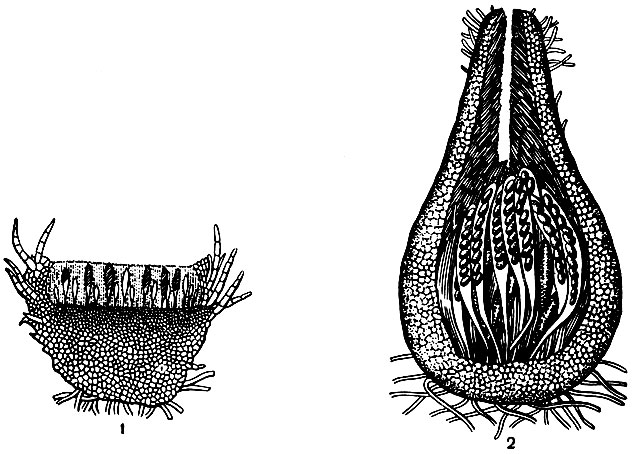
Basidial fungi They have multicellular mycelium and do not have germ cells. The sexual process involves the fusion of two cells (zygogamy). The nuclei in the zygote do not fuse (a dikaryon is formed), but divide independently. Nuclear fusion occurs during the formation of the basidium. The basidium is a cylindrical cell, at the end of which four basidial exospores develop. The basidia arises from a dikaryon located at the apex of the hyphae.
The most important of this class of mushrooms belong to the genera Merulius and Boletus. The house mushroom (Merulius lacrymans) vigorously destroys wood and therefore causes great damage to various wooden buildings, including their complete destruction.
Many species of the genus Boletus are known as good edible mushrooms: boletus, boletus, boletus, etc. The cap of an edible mushroom is a fruiting body that grows from mycelium in the soil. Fungi of this genus form mycorrhizae on the roots of many plants.
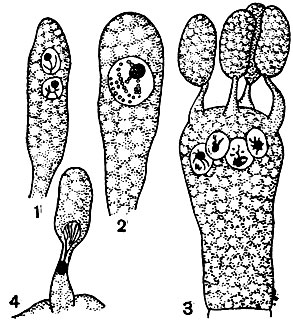
Basidial fungi include pests of agricultural plants - smut, rust fungi.
Imperfect mushrooms represent a conditionally united group of microscopic fungi, whose development has not been fully studied, and therefore their position in taxonomy has not been determined. They have a multicellular structure, sexual reproduction they don't know. Imperfect fungi are saprophytes. But some of them cause infectious diseases in humans and animals (scab, microsporia, trichophytosis, candidiasis). Fungi from the genera Cladosporium, Botrytis, Fusarium cause diseases of cotton, sugar beets and other agricultural plants.
Fungi from the genus Fusarium can cause poisoning - mycotoxicosis in humans and animals when eating cereal grains infected with this fungus. Toxic properties in a plant accumulate when it is affected by fungi that produce toxins. The toxin formed in grain infected with Fusarium sporotrichioides overwintered in the field causes a serious illness in humans with nutritional toxic aleukia (septic tonsillitis). This fungus can grow and accumulate toxin at low temperatures, even at 0°. Fusarium graminerum causes the poisoning known as "drunk bread". Stachybotrys causes equine mycotoxicosis.
The fact that yeast is a mushroom is probably known to many. What can be said about the further classification of these representatives of the kingdom? It is known that yeast belongs to the fungi of the division Ascomycetes and Basidiomycetes. What does this mean? Let's try to figure it out together.
Yeast - mushrooms
Moreover, fungi are unicellular. They lost their mycelium as a result of evolutionary processes, believed to be due to the transition to living in liquid substrates, which are rich in organic matter and very favorable for the life of these organisms. There are up to one and a half thousand species of yeast. All yeasts are unicellular fungi. 
Dimensions
Single isolated cells of these fungi reach up to 7 microns in diameter, but some grow up to 40 microns. However, some yeast-like organisms still form mycelium at their stages, and in some cases, a fruiting body. Currently, for example, baker's yeast is the first eukaryote whose genome has been identified and deciphered.
A little bit of history
Yeast is a mushroom “domesticated” by humans, and has been for quite a long time. They have long been used for thousands of years for culinary purposes: baking, creating fermentation conditions. Already in Ancient Egypt there were bakeries and, apparently, yeast was used. And in some countries ancient times, along with unleavened baking (for example, matzo or lavash), the production of yeast bread was gaining popularity. were known to the Egyptians more than six thousand years ago, and with the help of these organisms people brewed this foamy drink.
It is interesting that since ancient times, many farms have used the remains of the old one for new leavening. This is how, according to scientists, selection of yeast took place, and species not found in the wild appeared. And many consider some types of yeast to be an exclusive product (for example, varieties of cultivated cereals: wheat, rye and others).
Zymology
This is the name of the science that describes and studies the life and activities of these organisms. Yeast is a fungus; its pure culture was first isolated in 1881 in Denmark, and in 1883 it was already used to produce beer. At the end of the 19th century, a classification of yeast was created, and in the 20th century, collections and keys appeared famous cultures. Yeasts belonged to the fungi of the ascomycetes department until the middle of the last century. Scientists observed their sexual cycle, generalizing it as a taxonomic group. But in Japan, one of the scientists induced the reproduction of basidiomycete yeasts. Thus, experts came to the conclusion that yeast fungi (photo below) were formed in the process of evolution independently among these two divisions of the kingdom (ascomycetes and basidiomycetes). The data was confirmed by molecular biological research of organisms. They do not represent a taxon, but most likely a special life form. 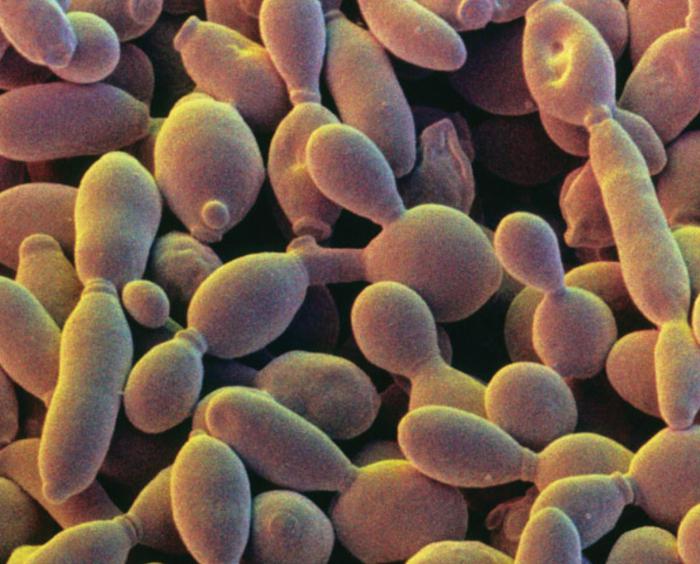
Ascomycetes and basidiomycetes
So, yeast belongs to the fungi of the ascomycetes and basidiomycetes departments (more precisely, to two different departments). All of them are the subkingdom of higher mushrooms. They can be distinguished by their characteristics life cycles and some other characteristics: pairs in DNA, the presence of urease. Ascomycetes, or marsupial fungi, are a fairly extensive department, including up to thirty thousand species (by the way, well-known truffles belong to this department, as well as morels and stitches). Among all of them is yeast, which is considered by scientists to be secondarily single-celled organisms.
Habitats
Typically, these organisms live in places that are rich in sugars - substrates on the surface of fruits and berries, leaves. They can feed on plant waste products: nectar, secretions, wound juices. They do not disdain dead phytomass. They can live in organic soil litter and natural water masses. Some yeasts are also present in the intestines of insects that feed on wood. There is a lot of yeast on leaves that are affected by aphids. 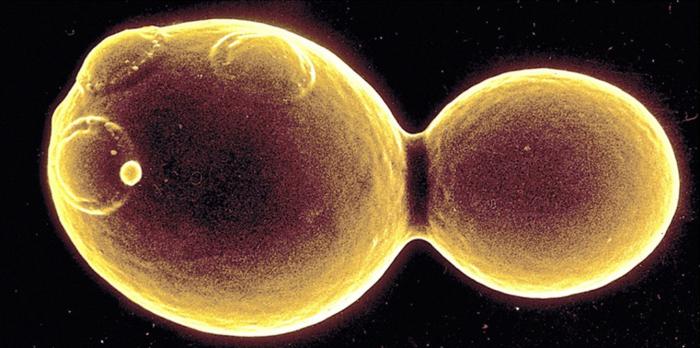
Application
Some types of yeast cultures have long been in demand in cooking, baking and distilling alcohol. Kvass, bread, beer, wine cannot do without these tiny helpers. All these yeasts, known to mankind for a long time, belong to the fungi of the ascomycetes department. To produce strong alcohol, they are involved in distillation during the fermentation stage. Nowadays, some yeast cultures are used in a wide range of biotechnologies: the production of fuels and food additives and enzymes. And in science they are used as experimental crops for genetic research. 
Saccharomyces cerevisiae

One of the main stages of winemaking (fermentation of grape must) is based on the process of alcoholic fermentation carried out by living yeast cells. During the fermentation process, the sugar contained in the juice is fermented by yeast, resulting in the formation of alcohol and carbon dioxide.
Alcoholic fermentation has been known to mankind since ancient times and has been used to produce alcoholic beverages for thousands of years. However, the essence of this process became known relatively recently. Only in the XV-XVI centuries. There are works that raise questions about the relationship between the sediment formed during fermentation and the product resulting from fermentation. But since the sediment could not be seen with the naked eye, it was impossible to explain the composition and essence of sediment in fermenting liquids. Only the invention of the microscope by the Dutchman Anton Leeuwenhoek in late XVIII V. allowed us to penetrate into a new world unknown to man.
More than 100 years ago, Cagniard-Latour, Schwann and Kützing established that fermentation is the result of the physiological activity of living organisms - yeasts that accumulate in the sediment during fermentation. This bold idea about the connection between fermentation processes and the vital activity of living beings was new and unexpected. For many years this theory was not recognized, since at that time only Liebig's chemical theory of fermentation was recognized.
In 1857, Louis Pasteur, the founder of modern microbiology, published a work in which he argued that alcoholic fermentation can only occur in the presence of living yeast and is the result of a special form of life activity without access to air. A bitter controversy ensued between Liebig and Pasteur, since the latter dealt a crushing blow to the prevailing views on fermentation at that time. But Pasteur's experiments were so conclusive and accurate that the chemical theory of fermentation became a thing of the past.
In 1866, Pasteur, in his work “Research on Wine,” proved that wines spoil as a result of processes caused by microorganisms. To combat the “diseases” of wines, he suggested heating them to 55-60°C after the wine is bottled. This technique is called "pasteurization".
At the end of the 70s. last century, Hansen developed a method for isolating pure yeast cultures from a single cell. With such crops, he conducted research on the taxonomy of mushrooms, studied their species, races, and variable forms.
However, for quite a long time it was believed that yeast is not an independent group of organisms, but only a form of development of fungi at a certain stage. Only to end of the 19th century V. It was recognized that yeasts represent an independent group of organisms, although they are related to fungi. Due to their ability to ferment sugars, they received the botanical name sugar mushrooms (saccharomyces).
Yeast organisms are currently divided into two large groups: true, true yeast (spore-forming) and yeast-like organisms (not forming spores). Both organisms are widespread in nature. They are found in the soil of vineyards, on green and fallen leaves, in the buds and inflorescences of the grapevine.
In the areas of fermentation industry enterprises and, in particular, wineries, the territory, premises and equipment contain a lot of yeast. Here the yeast is kept alive throughout the year and serves as food for the larvae and adult vinegar fly, ants, bees, wasps and other insects that visit the fruit, so yeast can almost always be found on grapes, apples, and pears. During the period of crushing and pressing the grapes, yeast enters the juice and quickly multiplies in it.
The quality of the wine produced depends on the quality of the processed grapes and winemaking technology. Both of these indicators are closely related to microorganisms that are on the surface of the grapes and, once in the must, continue to develop. Moreover, the overwhelming majority are fermentation weeds (wild yeast, bacteria and molds); There are much fewer true wine yeasts, which lead the main process of fermentation of grape must.
Thus, spontaneous fermentation of grape must, which occurs as a result of a random combination of various yeasts, cannot ensure the production of high quality wine. Therefore, in order to obtain fully fermented, healthy wine materials, it is necessary to observe a rational fermentation regime in primary winemaking, based on the use of pure cultures of selected yeasts, as well as take measures to protect wines from secondary infection during their processing and aging.
Shapes, size and structure of yeast cells
Yeasts are single-celled but motile microorganisms that have a variety of different shapes: spherical, oval or ellipsoid, ovoid, lemon-shaped, cylindrical, etc. The diameter of the cells reaches 1-5 microns, and the length - 1-10 microns or more. The same culture can consist of cells various shapes and sizes. Therefore, the shape and size of a given type of yeast are determined during their development in a liquid nutrient medium. Characteristic cells are the predominant shape and size.
Yeast cells consist of a membrane, cytoplasm (protoplasm) and nucleus (Fig. 1). The most important enzymatic processes take place in the protoplasm with its organelles (vacuoles, chondriosomes, microsomes) and inclusions (volutin, fat, glycogen and other reserve nutrients).
The protoplasmic substance of each yeast cell is surrounded by a transparent permeable membrane, which mainly determines the shape of the cell. Nutrients enter the cell through the membrane. In young cells the membrane is very thin, but with age it thickens.
Protoplasm has the appearance of a grayish, fine-grained semi-liquid mass. In young cells it is homogeneous - homogeneous. As the cell ages, fine vacuolization and uniform granularity from fine to coarse may appear in the protoplasm.
Visible granularity is determined by the appearance of fatty lipoid and other granular formations.
Vacuoles (cell organelles) contain electrolytes, proteins, fats, carbohydrates and enzyme systems dissolved in water. Chondriosomes (mitochondria) - small structures, having the form of grains and threads, play an important role in carbohydrate and fat metabolism. With special staining, chondriosomes can be observed under a regular microscope.
The nucleus plays an important role in cell reproduction. During microscopy it is not visible, and it is detected only as a result of special staining.
Cell Reproduction
Yeast reproduces by budding or fission (vegetative reproduction) and by producing ascospores (sexual reproduction).
During budding, part of the protoplasm and nuclear matter flows from the mother cell into the growing bud - a small tubercle on the membrane of the mother cell. A constriction forms at the base of the bud, separating the young cell from the mother cell. In dust-type yeast, the bud, having reached the size of the mother cell, separates and begins an independent life. In flocculent yeast, daughter cells, sitting on the mother cell, continue to budding and form large conglomerates (flakes), which quickly settle to the bottom of the fermentation vessel. If there is not enough of one or another substance in the nutrient medium or there is a toxic substance, then the process of cell growth slows down and the cell can form several small buds in different places (multiple budding - 3-4 buds), and some of them can quickly die. Yeasts of the Saccharomycetaceae family reproduce by budding (Fig. 2).
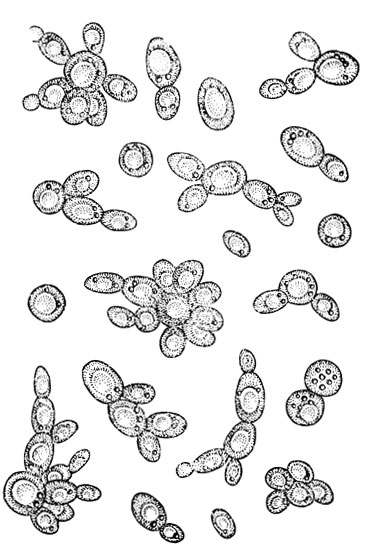
Yeast can also reproduce by cross division. The mother cell grows, lengthens, and a partition appears in the middle of it, which divides the cell into two equal daughter cells. This is how fission yeast of the Schizosaccharomycetacea family reproduces (Fig. 3).
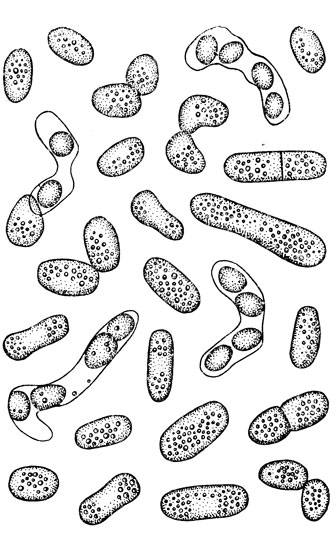
Yeasts of the family Saccharomycodacea reproduce by budding and division. A kidney-shaped outgrowth with a wide base that initially forms on the mother cell is then separated by a transverse septum (Fig. 4).
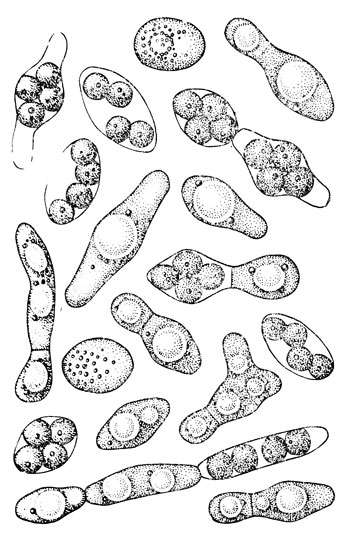
In many yeasts, the sexual process is known, and it differs from one yeast to another. Cells can copulate and as a result an ask is formed - a cell with 1-9 spores. They can copulate spores in the ascus. The formation of ascospores (supports located in the asci) is the process of reproduction and formation of forms that are more resistant to adverse conditions.
Stages of yeast development
Reproduction characterized by the presence of a large number of budding cells with homogeneous plasma and a thin membrane (Fig. 5, a).
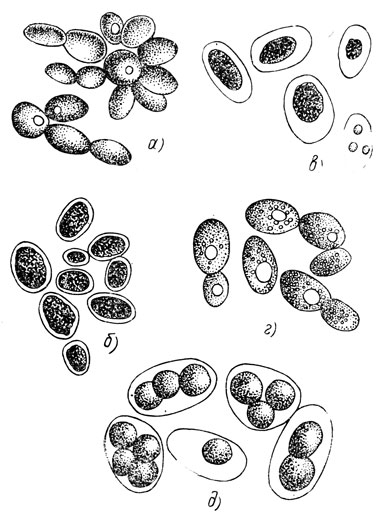
During fermentation Yeasts are mainly found in the form of individual cells. The cells have granular protoplasm, small vacuoles and a large supply of nutrients; With a rich carbohydrate diet, they accumulate glycogen.
Starvation cells occurs after all the sugar in the wort has been fermented. The cells become comparatively smaller, and the protoplasm takes on a granular appearance.
Dieback cell growth occurs as a result of long-term storage of yeast sediment in wine with insufficient or complete absence of atmospheric oxygen. Yeast cells are deformed, the protoplasm lags behind the shell (Fig. 5, b). In dead yeast cells, autolysis can be observed - the breakdown of proteins under the influence of their own proteolytic enzymes. The amount of protoplasm in autolyzing cells gradually decreases, the cells become almost empty with small droplets of fat (Fig. 5, c).
Resting cells (Fig. 5, d) are observed when the yeast remains in the wine sediment for a long time with access to atmospheric oxygen. Under these conditions, cells remain viable mainly due to organic acids.
Sporulation stage occurs in young, well-nourished cells with free access of air and lack of nutrition (Fig. 5, e). The spores of many yeast species have a characteristic size. Spores can persist for a long time, and when exposed to favorable conditions, they germinate and give rise to vegetative cells.
Metabolism
To build the components of protoplasm that ensure the growth and reproduction of the organism, energy and various substances. The consumption of these substances is replenished by nutrients that come from environment. Nutrients absorbed by the cell go in two main directions: part of them is assimilated and processed into components of protoplasm, the other part decomposes and oxidizes, releasing the energy necessary for life.
The main nutrition of yeast is carbon and nitrogen. They need carbon for growth and energy. The most favorable sources of carbon for the development of yeast are sugars, glycerin, citric, malic acids, etc. The source of nitrogenous nutrition for the synthesis of proteins and other nitrogen-containing compounds in the cell can be organic and inorganic ammonia forms of nitrogen, amino acids, and peptones. Various inorganic elements to create normal cell structure. In addition, vitamins are necessary for the development of yeast.
Yeast obtains the energy necessary for life through respiration or through alcoholic fermentation. In the presence of atmospheric oxygen, yeast obtains energy through respiration, oxidizing the energetic material to carbon dioxide and water. At the same time, they highlight greatest number energy:
C 6 H 12 O 6 + 6O 2 = 6CO 2 + 6H 2 O + 674 kcal (1)
Under anaerobic conditions (without air access) or with limited access to air oxygen, yeast obtains energy by breaking down carbohydrates into alcohol and carbon dioxide, i.e., during the process of alcoholic fermentation:
C 6 H 12 O 6 = 2C 2 H 5 OH + 2CO 2 + 27 kcal (2)
One gram molecule of sugar (180 g) releases 674 kcal of heat during respiration, and 27 kcal during fermentation, i.e. 25 times less. This is explained by the fact that alcohol (the final product) contains a significant amount potential energy- 325 kcal per 1 gram molecule. Thus, the small amount of energy obtained during alcoholic fermentation is replaced by the yeast with the ability to ferment large quantities of sugar.
Alcoholic fermentation
Alcoholic, or alcoholic, fermentation is the process of decomposition of sugars by microorganisms into alcohol and carbon dioxide. This process is used in the production of alcohol, glycerin, wine, beer, champagne and other products. The main causative agents of alcoholic fermentation are yeasts of the genus Saccharomyces. Greatest practical significance used in winemaking are yeasts of the species Saccharomyces vini.
The Gay-Lussac equation for alcoholic fermentation (2) above indicates only the initial and final products.
In reality, the conversion of sugar into alcohol and carbon dioxide is a complex enzymatic process consisting of many intermediate reactions. Along with alcohol and carbon dioxide, small amounts of so-called secondary fermentation products are formed from sugar: glycerin, organic acids, esters, aldehydes, higher alcohols, etc. For winemaking, the formation of secondary products during fermentation is of great importance. The bouquet of wine and its qualitative features largely depend on the ratio of secondary products, the formation of which is different for each type of yeast. The bouquet of wine also depends on the by-products of fermentation, which are formed not from sugar, but from other substances found in the fermentable substrates, mainly from amino acids as a result of their consumption by yeast during fermentation and propagation.
Interaction of yeast with the environment
One of the most important factors affecting the life of yeast is temperature. The optimal temperature for the development of wine yeast is -25-30°C, maximum -40°C, minimum -4°C.
At temperatures above 30°C, the processes of reproduction and fermentation are accelerated, but the yeast quickly dies off. If fermentation began at a favorable temperature, then further reducing it to 11-12°C has almost no effect on the fermentation ability of the yeast.
The destructive temperature for yeast is 60-70°C. The effect of high temperature is slightly weakened by the presence of sugars.
During the period of reproduction (budding) yeast needs air oxygen.
Pressure yeast tolerates well. The fermentation ability of yeast is inhibited only at pressures above 1 ati, caused by carbon dioxide formed during fermentation.
Sahara in wort in an amount of 18-20%, it is easily fermented with wine yeast. Yeast is capable of fermenting 25% of sugars; higher concentrations slow down fermentation. In concentrated sugar solutions (above 60%), yeast die due to loss of water. Zygosaccharomycetes are capable of developing in substrates with high osmotic pressure, due to sugar content of up to 80% and higher.
Alcohol delays fermentation. Most yeast organisms stop developing at an alcohol concentration of 6-8% vol., and fermentation stops at 14-15% vol. Some races of yeast of the Saccharomyces vini species ferment sugar up to 16% vol. alcohol, and yeast of the species Saccharomyces oviformis - up to 18% vol. As the temperature rises, the toxic effect of alcohol on yeast increases.
Acidic environments favorable for the development and functioning of yeast. The latter tolerate malic and lactic acids well, and somewhat worse tolerate tartaric and citric acids. The optimal pH value for the development of most yeasts is 3.5-4.5. Fermentation at low pH values retards the development of pathogenic bacteria; at a pH below 2.6, yeast development is inhibited.
Sulfurous acid used in winemaking as an antiseptic and antioxidant. Yeasts are highly resistant to it. Sulfitation with doses of 150-200 mg/l of total SO 2 at a temperature of 20-25 ° C delays the proliferation of wine yeast and ensures clarification of the must during settling. At a SO 2 concentration of up to 50 mg/l, fermentation is delayed for 18-24 hours, at a SO 2 content of 75-100 mg/l - for 2-4 days, and at 200 mg/l - for 6-8 days.
However, it should be noted that the main amount of sulfur dioxide introduced into wine and must is in a bound state (in combination with sugars, acetaldehyde, dyes), and only free sulfurous acid(20-30% of the administered amount). Must from different grape varieties binds sulfurous acid differently.
Fermentation of highly sulfated worts should be carried out with yeast accustomed to high doses of SO 2.
Real wine yeast
Representatives of yeast, which have a positive or negative significance in winemaking technology, are divided into 2 groups: 1) true wine yeast, 2) fermentation weeds (wild yeast).
True wine yeasts include the yeast species Saccharomyces vini and Saccharomyces oviformis.
Saccharomyces vini. The main habitat of this yeast is the juices of berries and juicy fruits used for making wine. The shape and size of cells depend on development conditions and nutrient medium. In most cases, yeast of this species have oval or elliptical cells, sometimes round (see Fig. 2). They have the ability to deeply ferment the sugars of grape must with the formation of large quantities of alcohol (up to 16% vol.) and very small quantities of volatile acids (up to 1 g/l). During fermentation, this yeast does not form bad-smelling volatile esters and gives the wine a delicate bouquet and good taste.
The yeast species Saccharomyces vini includes a large number of races that differ little in appearance, but significantly - in fermentation strength, in relation to the effects of temperature, in acid tolerance, in sulfite resistance, etc. Therefore, for the production of different types of wines, the choice of yeast races is important.
Saccharomyces oviformis. A pure culture of this yeast develops well in wine; during fermentation of grape must it can form about 18% vol. alcohol When developing together in fruit and berry juices, the yeast of the described species is replaced by the more common and stronger yeast Saccharomyces vini. Conversely, when fermenting alcoholized wines, yeast of the Saccharomyces oviformis species is always released. Consequently, the latter are more adapted to living in wine.
A variety of yeast of this type is sherry yeast, characteristic feature of which is the ability to form a film on the surface of a fermented substrate. When grape must is fermented with sherry yeast, a sediment is formed, and at the end of fermentation, after 10-15 days (sometimes earlier, depending on the alcohol concentration), a film forms on the wine.
Film growth most often begins with the formation of individual small islands, which, connecting with each other, form a continuous, thin, curd-like film. With age, the color of the film changes from white, pinkish-fawn to gray, dark gray. In old crops or under unfavorable conditions, the film darkens and gradually falls off.
The optimal temperature for the development of sherry film is 18-20°C. In the presence of 16-17% vol. alcohol, these yeasts develop well on the surface of grape wine and oxidize alcohol into aldehyde. The latter, along with acetals formed during the interaction of alcohol with aldehydes, gives a specific bouquet to sherry.
Wild yeast (fermentation weeds)
Hanzeniaspora apiculata. This yeast is well known as apiculatus. They are small in size, the cells are pointed at one or both ends, and their shape resembles a lemon. In mature cultures, oval and elongated cells are found (Fig. 6).

Once in the wort, apiculata multiply in it much faster than wine yeast, releasing bitter substances and many volatile acids and esters. After accumulation in the fermenting wort 3-6% vol. When exposed to alcohol, the apiculata die off, giving way to more alcohol-tolerant yeasts. Their waste products inhibit fermentation, weakening the fermentation ability of wine yeast.
They cause defects and spoil the aroma and taste of wine.
Apiculata are very sensitive to sulfur dioxide (they die at 70 mg/l); therefore, their development can be easily suppressed by sulfitation of the wort during settling (dose - 100 mg/l).
Schizosaccharomyces. This is fission yeast (see Fig. 3). Selected species This genus is widely used in the distilling industry of Argentina and Mexico, which is explained by their ability to develop at elevated temperatures and give a high yield of alcohol.
Fission yeast developing in fruit and berry juices (especially apple juices) causes a catastrophic decrease in acidity. Malic acid breaks down into carbon dioxide and water, causing juices and wines to spoil.
Saccharomykodes Ludwigii. Yeast cells are large in size, oval, lemon-shaped, sole-shaped (see Fig. 4). Form up to 12% vol. alcohol and are very sulfite-resistant, therefore they retain their activity throughout the entire fermentation process of the wort. These yeasts secrete substances that stop the reproduction and inhibit the fermentation ability of wine yeast, and also spoil the wine, giving it an unpleasant aftertaste.
Membranous yeast. The group of filmy yeasts includes yeasts of the genera Hansenula, Pychia, Zygopychia, Debariomyces, Brettanomyces, Candida mycoderma and others, known in winemaking under common name mycoderms. They reproduce by budding and grow on the surface of the wine in the form of a thin and then thick wrinkled film. The cells are loosely connected to each other, so when the liquid is shaken, the film falls off. Filmy yeast energetically oxidizes alcohol, acids, glucose and other substances in wine to carbon dioxide and water. The growth of this yeast stops only at 12% vol. alcohol Some of them can live deep in the must or wine, fermenting sugars with the formation of volatile acids and ethyl acetate, which have an adverse effect on the taste of wine.
Fermentation with pure yeast cultures
Spontaneous fermentation occurs when the wort is left to ferment without adding pure yeast cultures. In the wort, microorganisms that have entered it from the berries begin to multiply randomly, the composition and quantity of which can be varied. First, the fastest growing but less alcohol-resistant weed yeasts (apiculata and membranous) predominate. As alcohol accumulates in the wort, they all gradually die off, giving way to more alcohol-resistant wine yeasts.
Wines fermented with wild yeast or with a large participation of them are poorly clarified, often contain unfermented sugar, become sick more easily and have poor taste.
In order to prevent the development of foreign microflora in grape must, sulfitation of the must and its settling have been introduced into winemaking practice. After settling the sulfated juice, wine yeast is also removed along with the sediment. Therefore, to carry out fermentation, a pure culture of wine yeast with previously known properties that are valuable for production is introduced into the wort. The amount of dilution should reach 2% or more of the volume of the entire wort to be fermented, i.e. 2 dcl for every 100 dcl of wort. If the must is made from contaminated, damaged or diseased grapes, the amount of yeast added should be increased to 4-5%.
Wines made with pure yeast cultures usually ferment evenly, ferment more fully, clarify quickly, have good flavor and aroma, and are resistant to disease. The amount of alcohol formed in wine increases by 0.5-1.0%.
Pure yeast cultures include yeast isolated from one cell and specially selected through selection for the preparation of certain types of wines - table, champagne, semi-sweet, dessert, etc. The collection of pure cultures of VNIIViV "Magarach" * contains over 400 races of wine yeast taken from different wine regions Soviet Union. Every year, before the start of the winemaking season, the institute sends pure cultures of wine yeast in test tubes at the request of state and collective farm wineries.
* (All-Union Scientific Research Institute of Winemaking and Viticulture "Magarach".)
Currently, the following yeast races are recommended for the preparation of various types of wines:
for the preparation of champagne and white table wine materials: Feodosia 1-19 (alcohol-resistant, sulfite-resistant), Pino 14 (alcohol-resistant), Leningradskaya (alcohol-resistant, cold-resistant), Uzhgorod 67 (alcohol- and sulfite-resistant), Sersial 14, Kakhuri 7, Ashgabat 3 (thermal-resistant);
for strong and dessert wine materials: Massandra III (flaky, alcohol-tolerant), Pike-perch VI-5 (flaky, acid- and alcohol-tolerant);
for red table wine materials: Cabernet 5, Bordeaux, Saperavi 46;
for preparing semi-sweet table wines: Novotsimlyanskaya 3 (prone to poor fermentation, ferments without foaming);
for sherry type wines: Sherry 20-C, Sherry 96;
for the production of champagne using the bottle method: Sudak VI-5, Kakhuri 7, Kakhuri 2;
for tank champagne: Leningradskaya, Rkatsiteli 6.
Let's look into the soil. The figure shows that all three fly agarics are connected underground by a network that looks like cotton wool and consists of intertwining and branching threads. This is the main part of the mushroom - mycelium. She is one. Therefore, even though you see three fly agarics, there is only one mushroom here. And above the ground - three fruiting bodies this mushroom.
Not only fly agaric, but also the vast majority of other mushrooms are a plexus of mycelium threads. Threads can be not only in the soil. U tinder fungus, for example, they pierce a tree, ergot entwine the insides of living grains of cereals, and the mycelium empusa is located in a living fly.
Tinder fungi play an important role in the life of the forest. They settle on still living but decrepit trees, accelerating the change of their generations.
Polypores- very large mushrooms. And there are mushrooms that are very small, for example yeast.
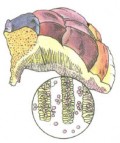 |
| tinder |
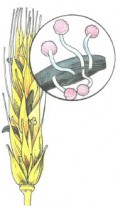 |
| Ergot |
You will probably say: “What kind of mushrooms are these? I saw yeast: it comes in powder form or in the form of pieces in packs. And they don’t have mycelium, which means they’re not mushrooms.”
Yeast- These are single-celled fungi that do not form mycelium threads. Yeast cells can have different shapes, but most often they are oval.
In nature, yeast lives in a variety of places: on the surface of many berries and other juicy fruits, in the intestines of some insects, even in sea water.
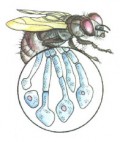 |
| Empuza |
Easiest to discover white coating yeast on plums and grapes. If smoked sausage is covered on the outside with a white coating, it turns out that this is also yeast. Of course, different yeasts are found in different places. Yeast has long been domesticated by humans. For the first time he began to use yeast to leaven dough.
What does yeast do to dough? They destroy the sugar that is put into the dough. At the same time, sugar is converted into other substances - alcohol and carbon dioxide. Almost all the alcohol evaporates (when something is baked from the dough), and carbon dioxide, collecting in bubbles, expands the dough, and it becomes fluffy. Material from the site
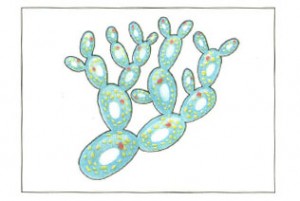 |
| Yeast |
| Dough |
Take a closer look at the bread: it seems to consist entirely of small bubbles surrounded by a thin layer of baked dough.
